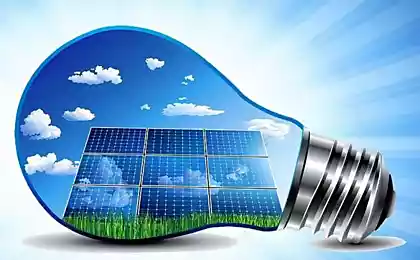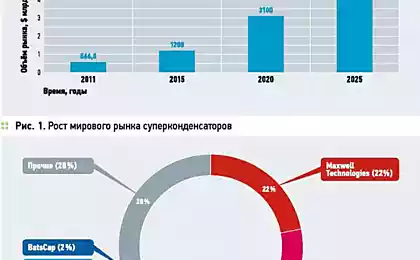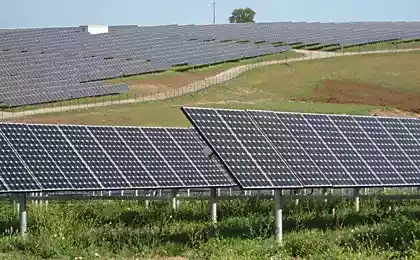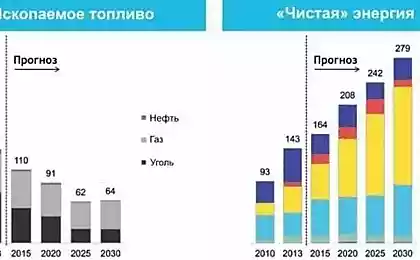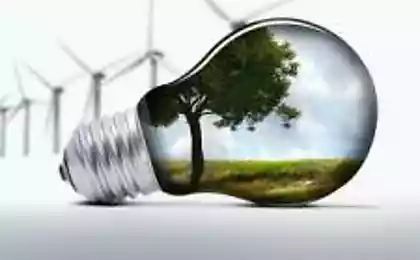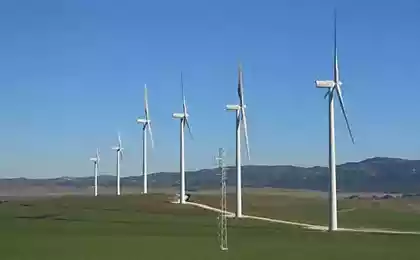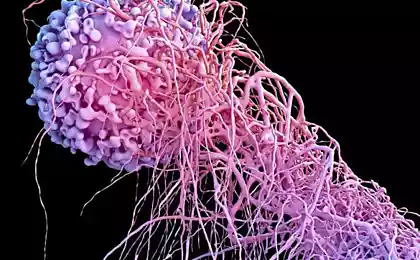934
10 alternative energy sources about which you knew nothing

To solve the problem of limited fossil fuels, researchers around the world are working to create and implement alternative energy sources. And it's not just about the well-known windmills and solar cells. To replace gas and oil energy can come from algae, volcanoes and human steps. Ten of the most interesting and environmentally friendly energy sources of the future.

Joules from tournikiotis people every day pass through the turnstiles at the entrance to the train station. In several research centers around the world had the idea to use the flow of people as an innovative power generator. The Japanese company East Japan Railway Company decided to equip each turnstile at the train stations generators. Installation works at the station in Tokyo's Shibuya district: the floor under the turnstiles integrated piezoelectric elements, which produce electricity from the pressure and vibration they receive when people step on them.
Other technology "energy gates" is already in use in China and in the Netherlands. In these countries, engineers decided to use the effect of pressing the piezoelectric elements, and the effect of pushing the handles of the turnstile or the door-gates. The concept of the Dutch company Boon Edam involves the replacement of standard doors at the entrance to shopping malls (which typically operate on the system of solar cells themselves begin to spin) on the door, which the visitor should move and thus produce electricity.
In the Dutch centre Natuurcafe La Port are door-generators have already appeared. Each of them produce about 4,600 kilowatt-hours of energy per year, which at first glance may seem insignificant but serves as a good example of alternative technology for electricity generation.

Algae dominadoras heat of steel be considered as an alternative source of energy is relatively recent, but the technology, according to experts, very promising. Suffice it to say that from 1 hectare of water surface occupied by algae, in a year you can get 150 thousand cubic meters of biogas. This is approximately equal to the volume of gas which produces a small hole, enough for the life of the small village.
Green algae easy to keep, grow fast and are many types that use the energy of sunlight to carry out photosynthesis. All biomass, whether it's sugar or fats, can be converted into biofuels, mostly bioethanol and biodiesel. Algae — the perfect eco-friendly fuel, because growing up in the aquatic environment and do not require land resources possess high productivity and does not harm the environment.
Economists estimate that by 2018, the global turnover from biomass of marine microalgae may be about 100 billion dollars. There are already implemented projects on "algae" fuel — for example, a 15-apartment building in Hamburg. The house facades are covered with 129 aquariums with algae that serve as the only source of energy for heating and cooling the building, dubbed the Bio Intelligent Quotient (BIQ) House.

"Speed bumps" covering policycontact generate electricity by means of a so-called "speed bumps" began to be implemented first in Britain, then in Bahrain, and soon the technology will reach Russia. It all started with the fact that British inventor Peter Hughes has created a "Generation of road rail" (Electro-Kinetic Road Ramp) road. The ramp consists of two metal plates, slightly rising above the road. Under plates laid electric generator, which generates a current whenever the car drives over the ramp.
Depending on the weight of the vehicle ramp can produce from 5 to 50 kilowatts during the time until the vehicle passes the ramp. Such ramps as the batteries can supply electricity to the traffic lights and illuminated road signs. In the UK, the technology is already in several cities. Method began to spread to other countries — for example, in little Bahrain.
The amazing thing is that something similar can be seen in Russia. A student from Tyumen albert brand offered the same solution for street lighting at the forum", Souzpromexpo". According to the calculations of the developer, a day for "speed bump" in his town goes from 1000 to 1500 cars. For one "hitting" the car is equipped with electrogeneration "the lying policeman" will generate about 20 watts of electricity, without harming the environment.

More than just footballrecruiting a group of Harvard alumni, the founders of Uncharted Play, the Soccket ball maybe a half hour game in football to generate electricity, which is enough to feed a few hours LED lamp. Soccket is called an environmentally friendly alternative to unsafe sources of energy, which are often used by residents of underdeveloped countries.
The principle of accumulation of energy the Soccket ball is quite simple: the kinetic energy generated from hitting the ball, passed the tiny mechanism, like a pendulum, which drives a generator. The generator produces electricity that is stored in the battery. The saved energy can be used to power any small appliance — such as a table lamp with led.
Soccket output power is six watts. Generating the energy the ball has already won international recognition: received numerous awards, was highly appreciated by the organization Clinton Global Initiative, and received laudatory reviews at the famous TED conference.

Latent energy Volcanology of the main developments in the development of volcanic energy belongs to the American researchers from the companies-initiators of AltaRock Energy and Davenport Newberry Holdings. "Subjects" has become a dormant volcano in Oregon. Salt water is pumped deep into the rocks, where the temperature due to the decay present in the planet's crust radioactive elements and the hot mantle of the Earth is very high. When heated the water turns to steam, which is fed into a turbine that produces electricity.
At the moment there are only two small existing power plants of this type in France and in Germany. If American technology is working, then, according to the U.S. Geological survey, geothermal energy has the potential to provide 50 percent of its required electricity (today its contribution is only 0.3%).
Another way to use the volcanoes for energy proposed in 2009, Icelandic researchers. Near volcanic subsoil they found an underground water reservoir with abnormally high temperature. Super-hot water is somewhere on the border between liquid and gas exist only under certain temperature and pressure.
Scientists could generate something similar in the lab, but it turned out that this water occurs in nature in the bowels of the earth. It is believed that out of the water "critical temperature", you can extract ten times more energy than from the water, brought to a boil the classic way.

Energy from heat chelovechische thermoelectric generators operating on the difference of the temperatures known for a long time. But only a few years ago, technology began to allow the use as energy source of human body heat. A group of researchers from leading Korean scientific-technical Institute (KAIST) developed a generator integrated in a flexible glass plate.
This gadget will allow fitness bracelets recharged from heat of a human hand, for example, in the process of running when the body becomes too hot and contrasts with the ambient temperature. Korean generator with a size of 10 by 10 centimetres can produce around 40 milliwatts of energy when the skin temperature of 31 degrees Celsius.
A similar technology has taken young Anne Makosinski who invented a flashlight powered from the temperature difference between air and the human body. The effect is due to the use of four Peltier elements: their peculiarity is the ability to generate electricity when heated on one side and cooled on the other side.
In the end, the flashlight Ann produces a fairly bright light, but does not require a battery-acumulatorul. It requires only a temperature difference of only five degrees between the degree of heating the palm of the person and temperature of the room.

Steps on sidewalk placena any point on one of the busiest streets we have up to 50,000 steps a day.The idea of using pedestrian flow for useful transformation steps in energy was implemented in the product, was developed by Lawrence Kemball-cook, Director of Pavegen Systems Ltd British. The engineer had created a paving slab that generates electricity from the kinetic energy of walking pedestrians.
The device is innovative in a tile made of flexible waterproof material which, when pressed, flexes about five millimetres. This, in turn, creates energy, which mechanism converts into electricity. Accumulated watts is either stored in lithium polymer battery, or just go to lighting, bus stops, shop Windows and signage.
Pavegen tile itself is absolutely environmentally friendly: its body is made of stainless steel special grade and recycled polymer with low carbon content. The upper surface is made from used tires, thanks to this tile has strength and high abrasion resistance.
During the summer Olympics in London in 2012 tile installed in many tourist streets. For two weeks managed to get 20 million joules of energy. This is enough for work of street lighting in the British capital.

The bike is charging SmartMonitor to recharge the player, phone or tablet, do not necessarily have on hand the socket. Sometimes it is enough only to twist pedals. Thus, the American company Cycle the Atom has released a device that allows you to charge the external battery while riding the bike and subsequently recharge the mobile device.
The product is called the Siva Cycle Atom is a lightweight Bicycle generator with a lithium battery designed to power almost any mobile device with a USB port. This mini alternator can be mounted on most conventional Bicycle frames in a matter of minutes. The battery is easily removed for subsequent charging gadgets. The user plays sports and pedals — and a few hours later, the smartphone is already charged 100 potsentov.
Nokia also unveiled a gadget that attaches to your bike and allows you to transfer the torsion of the pedals in the way poluchaya environmentally safe energy. Set Nokia Bicycle Charger Kit has a Dynamo, a small electrical generator that uses energy from the rotation of the wheels of the bike and recharges her phone through a standard two-millimeter connector, common in most Nokia phones.

The benefits of waste vollyball big city daily resets in open water a huge amount of wastewater, polluting the ecosystem. It would seem, poisoned by sewage water no one can come in handy, but it isn't — scientists have discovered a way to create on its basis a fuel cell.
One of the pioneers of the idea became a Professor at the Pennsylvania state University Bruce Logan. The overall concept is very difficult for the layman ponmaniya and is built on two pillars — the use of bacterial fuel cells and the installation of so-called reverse electrodialysis. Bacteria oxidize organic matter in wastewater and produce in this process electrons, creating electric current.
For the production of electricity can be used almost any organic waste material – not only wastewater, but also animal waste and by-products of production in winemaking, beer brewing and dairy industries. As for reverse electrodialysis, there are generators, separated by membranes into cells and extracting energy from the difference in salinity of two miscible fluid flows.

"Paper" energiemesse electronics manufacturer Sony has developed and introduced at the Tokyo exhibition of organic products bio-generator that can produce electricity from finely cut paper. The process is as follows: for separation of the cellulose (it is a long chain sugar glucose, which is found in green plants) is necessary corrugated cardboard.
The chain is broken by enzymes, and resulting from this glucose is processed by another group of enzymes, which are released hydrogen ions and free electrons. The electrons are routed through an external circuit to generate electricity. It is assumed that a similar setup during the processing of a single sheet of paper the size of 210 mm by 297 mm can produce about 18 watts per hour (about the same amount of energy produced 6 AA batteries).
The method is environmentally friendly: an important advantage of this "battery" is the absence of metals and harmful chemical compounds. Although at the moment the technology is still far from commercialization: the electricity produced is quite small – it is only enough to power a small portable gadget.published
Source: recyclemag.ru/article/10-neobychnyh-alternativnyh-istochnikov-energii


